

Viewcontent. What’s Going On in This Picture - The Learning Network Blog - The New York Times. Photo Students 1.
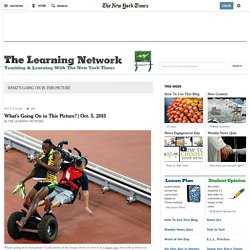
After looking closely at the image above (or at the full-size image), think about these three questions: What is going on in this picture? What do you see that makes you say that? Read more… Updated: Oct. 2, 2015 1. Read more… Updated: Sept. 25, 2015 1. Picture_Perfect_Science_3-6.pdf. Images of Science. Photo Credit: Science NetLinks Purpose To understand the diversity of the scientific enterprise.
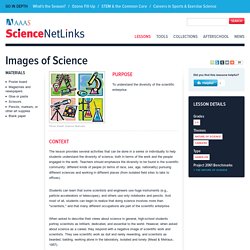
Context. Reading images: an introduction to visual literacy. “Literacy” usually means the ability to read and write, but it can also refer to the ability to “read” kinds of signs other than words — for example, images or gestures.
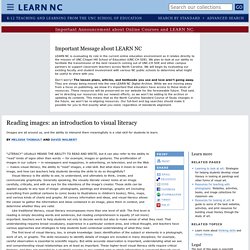
The proliferation of images in our culture — in newspapers and magazines, in advertising, on television, and on the Web — makes visual literacy , the ability to “read” images, a vital skill. Visual Literacy: Lesson Plans. Digital Activities For Visual Literacy. Visual literacy is the ability to construct meaning from or communicate meaning through information presented in the form of an image.
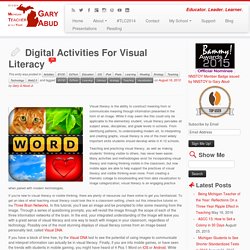
While it may seem like this could only be applicable to the elementary student, visual literacy pervades all subject areas, disciplines, and grade levels in schools. Teaching Visual Literacy to Students. Visual literacy is a multi-faceted subject matter, and faculty wishing to include images in their curriculum can quickly find themselves overwhelmed by the prospect of addressing visual literacy. For an introduction to the topic visit The Basics of Visual Literacy: Form, Context and Content.
The following tools are intended to help faculty customize their curricula to incorporate visual literacy in ways that suit their individual instructional needs. Some faculty may want to teach visual literacy as a one-time in- or out-of-class activity. Others may want to teach visual literacy as multi-week or semester-long elements of their courses. Each one of the following tools can stand alone, or they can be combined with one another to build a customized visual literacy curriculum that suits your needs.
Online Activities: a complilation of online activities contributed by faculty. EyeWitness to History - history through the eyes of those who lived it. Institut culturel de Google. LIFE photo archive hosted by Google. Smithsonian's History Explorer. Teaching History Resources - Historic Newspapers. Looking after the world’s largest private archive of original newspapers means that we’re extremely passionate about history.

This is why we decided to pick out interesting coverage from historical dates of significance so that others could learn about the past, as it was reported at the time! Our free teaching packs are available in order to help students discover the cause and consequence of historical events. Hard copies are currently available to schools, universities, libraries and accredited education establishments only. UFDC Home - All Collection Groups. National Archives Experience.
Teachers' Resources. Teacher Resources. The Library of Congress offers classroom materials and professional development to help teachers effectively use primary sources from the Library's vast digital collections in their teaching.
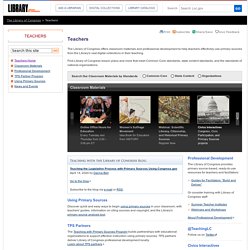
Find Library of Congress lesson plans and more that meet Common Core standards, state content standards, and the standards of national organizations. Discover and discuss ways to bring the power of Library of Congress primary sources into the classroom. Go to the blog Subscribe to the blog via e-mail or RSS. A Pictures Worth. A Picture’s Worth Analyzing Historical Photographs in the Elementary Grades Keith C.

Barton A picture can be worth a thousand words—and maybe a lot more. Social Studies. Hofer, M., & Swan, K.
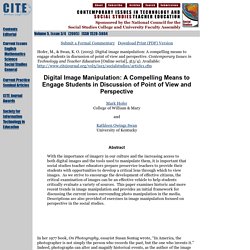
O. (2005). Using Historical Photographs in Teaching - History and Using Photographs in Teaching. Period photographs, along with other primary source documents, are engaging yet deceptive historical tools that should become an important part of any educational experience if available.
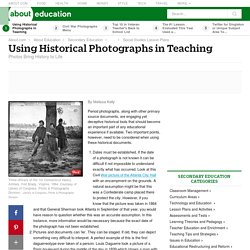
Two important points, however, need to be considered when using these historical documents. Dates must be established. If the date of a photograph is not known it can be difficult if not impossible to understand exactly what has occurred. Look at this Civil War picture of the Atlanta City Hall with an encampment on the grounds. A natural assumption might be that this was a Confederate camp placed there to protect the city.
06465_no7.pdf. Using Pictures to Build Schema for Social Studies Content. ReadWriteThink couldn't publish all of this great content without literacy experts to write and review for us.
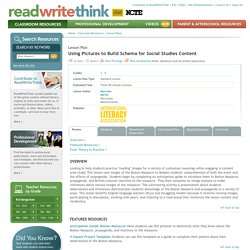
If you've got lessons plans, videos, activities, or other ideas you'd like to contribute, we'd love to hear from you. More Find the latest in professional publications, learn new techniques and strategies, and find out how you can connect with other literacy professionals. More Teacher Resources by Grade Your students can save their work with Student Interactives. Using Visual Materials as Historical Sources: A model for Studying State and Local History. Using Visual Materials as Historical Sources: A model for Studying State and Local History The Social Studies, March/April 1990, pp 84-87 A Questioning Model for Using Historical Photographs. Tops.pdf. Using Picture Books to Teach Characterization in Writing Workshop. ReadWriteThink couldn't publish all of this great content without literacy experts to write and review for us. If you've got lessons plans, videos, activities, or other ideas you'd like to contribute, we'd love to hear from you.
More Find the latest in professional publications, learn new techniques and strategies, and find out how you can connect with other literacy professionals. More Teacher Resources by Grade Your students can save their work with Student Interactives. Werff- Using Pictures from Magazines in ESL Classes. The Internet TESL Journal Joep van der Werffjoepvdw [at] yahoo.comInterlingua (Mexico City, Mexico) The purpose of this article is to show that pictures from magazines are a source of varied classroom activities in the areas of speaking, listening, writing, vocabulary and grammar. I'll give tips on how to collect and sort suitable pictures and I'll include several sample activities. Teachers can use the activities as they are presented, or adapt them to fit their needs. Introduction Several years ago I was teaching a beginning level class.
Using Photos With English-Language Learners. "A picture is worth a thousand words. " -- Unknown Though the origin of this popular adage is unclear, one thing is clear: using photos with English-Language Learners (ELLs) can be enormously effective in helping them learn far more than a thousand words -- and how to use them. Usable images for lessons can be found online or teachers and students can take and use their own. The activities presented below connect to multiple Common Core Standards including the following ELA Standards: Integrate and evaluate information presented in diverse media and formats, including visually, quantitatively, and orally.
Develop the topic with relevant, well-chosen facts, definitions, concrete details, quotations, or other information and examples. Guide... This list provides examples of ways in which digital images can be used in teaching and learning materials. It has been put together to inspire lecturers new to using digital images: however it is not comprehensive! The list does not differentiate between types of image e.g. photographic, vector, chart or graph.
Interpreting Political Cartoons in the History Classroom. Political Cartoon Interpretation ~ Government Critical Thinking Strategies. This critical thinking skill is included because of the many political cartoons students will encounter in government courses. Have students practice frequently with the template using sample cartoons found in their textbooks, newspapers, and news magazines. Cartoon_analysis_worksheet.pdf. Great Resources and Tools for Teaching Using Comic Strips. Inferences_without_captions_packet.